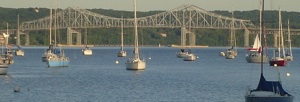 by Dave Zornow
by Dave Zornow
Productive talks about how to fund a replacement Tappan Zee Bridge have been drowned out by DC conversations about raising the debt limit and Albany legislation to impose a two percent property tax cap. But the TZB continues to age and it costs millions each year to maintain. And that’s a cost that will only increase over time.
“The longer it takes to tackle a major rehabilitation or replacement of the bridge, the more costly the additional maintenance projects will become,” said NYS Department of Transportation Acting Commissioner Stanley Gee. “It is probably one of the few pieces of infrastructure where the ‘€œno build’€ scenario could cost more than a billion dollars.”
Two articles last week reminded us that unlike the line-in-the-sand debt crisis in Washington, the TZB build project has real financial impacts for everyone who lives along the I-287 corridor.
- San Diego PBS station KPBS says that commuting is stressful — but not in the way that most commuters feel that pain. “Bridges, like the one that collapsed in Minneapolis four years ago, are especially stressed and vulnerable,” writes blogger Tom Fudge in an article called Our Dying Freeways. “The Tappan Zee Bridge, which crosses the Hudson River in New York City, was built to handle 18,000 cars a day. It now carries 150,000.”
- A proposal by Westchester County Executive Rob Astorino to speed up the Tappan Zee Bridge project by dropping the mass transit option gets a raised eyebrow from the Tri-State Transportation Campaign. “Delaying the bus rapid transit system would be a losing proposition for the region,” writes Steven Higashide at tstc.org. “A BRT (bus rapid transit) system would bring fast, frequent transit across the corridor for the first time. It would carry over 50,000 riders throughout the I-287 corridor daily and connect economic centers such as White Plains and the ‘Platinum Mile’ of office parks with residential areas, regional destinations, and existing rail lines,” he says.
A tip of the hat to Astorino for getting the conversation moving. But Westchester’s County Executive also gets a wag of the finger for suggesting a politically expedient solution that ignores both the recommendations of the bridge builders and the lessons of history. ‘€œWe can’t build our way out of congestion,’€ said Tappan Zee Bridge/I-287 Corridor Project Director Michael Anderson. Which is part of the justification for spending almost half of the $16 billion price tag on improving mass transit in the region.
History has shown us that increasing capacity for cars and trucks only increases demand and congestion. With an almost ten fold increase in car traffic on the TZB since it was built 55 years ago, the region needs more than a few new lanes to satisfy future transportation needs.
Many of the the expedient and cost-saving decisions when the Tappan Zee Bridge was being built have cost us dearly, frequently causing today’s planners to roll their eyes about their predecessor’s short-sightedness. Let’s not make those same mistakes again.
Sources:
- Our Dying Freeways, KPBS On-ramp blog 7/28/2011
- A Tappan Zee Bridge With No Transit? tstc.org 7/28/2011
- Funding Still in Flux For New TZB 10/16/2010
- NYS DOT Acting Commissioner Stanley Gee remarks at the New York State Infrastructure Summit, 5/12/2009








